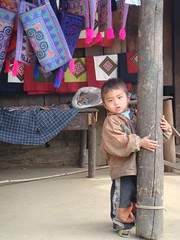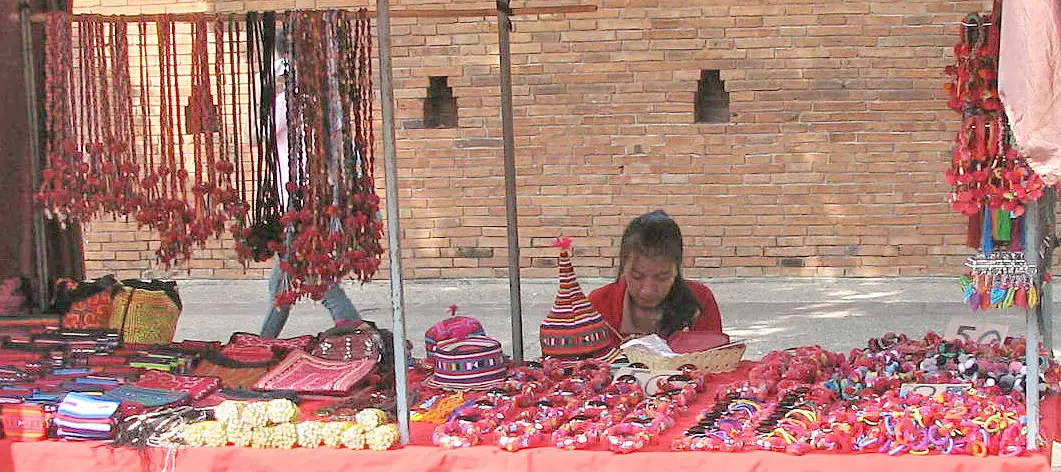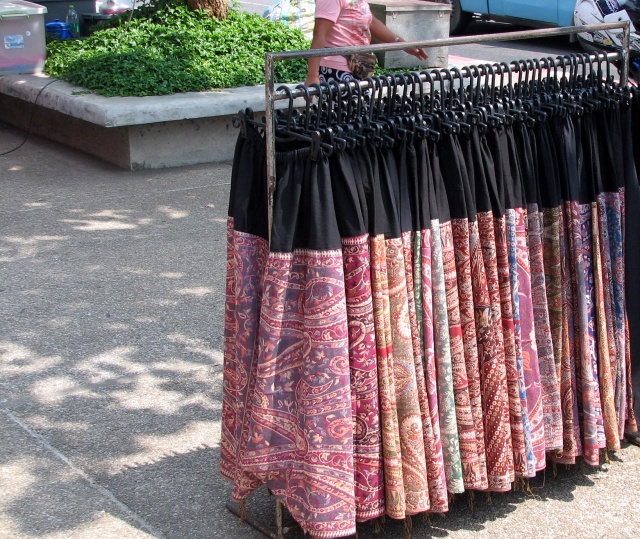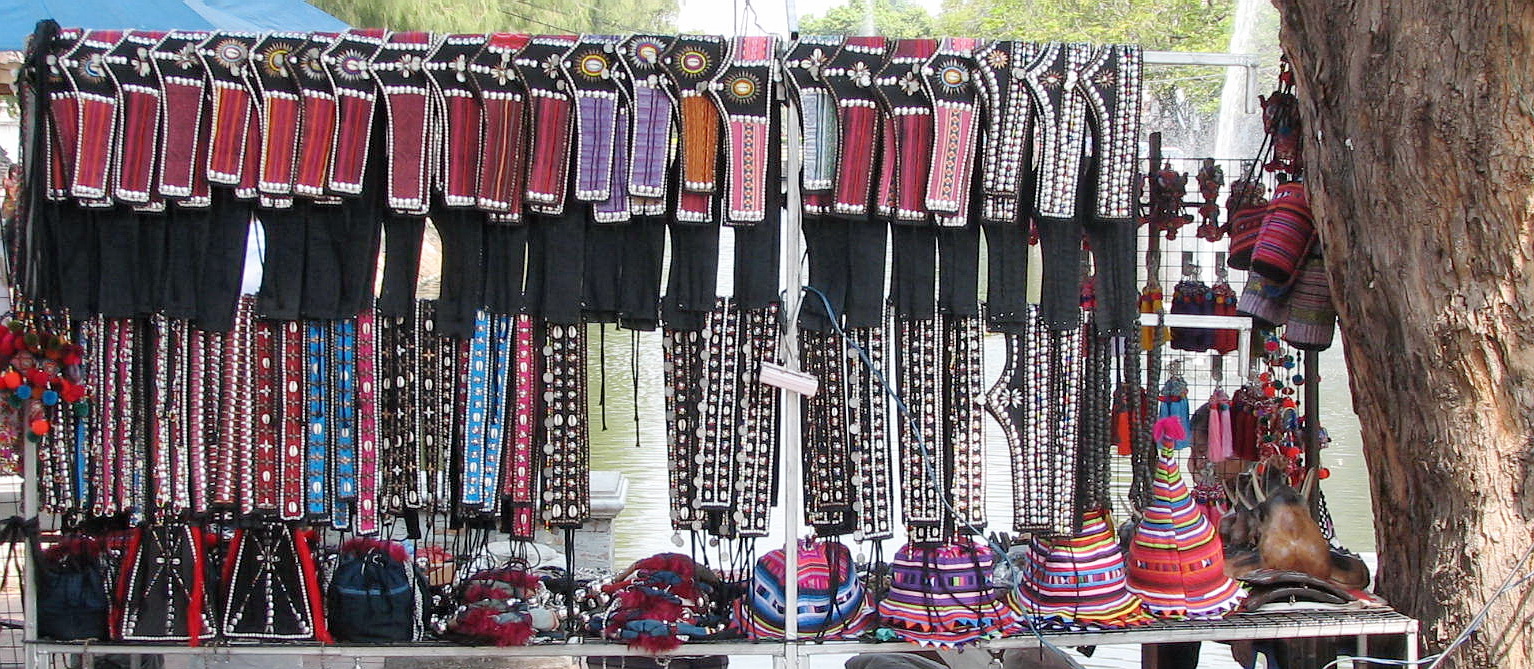In Northern Thailand, Hill Tribes in Chiang Mai comprise industrious, quiet and respectful people. The Hmong hill tribe is the most overt of Thailand hill tribes in the province. During the Vietnam War the Americans used the Hmong tribe in Laos. And according to some CIA veterans, so many of them lost their lives fighting that whole families were destroyed and the Hmong tribe was in jeopardy of extinction. Like the Myanmar Rohingyas they are among the large number of marginalised ethnic minorities and indigenous people in Asia.
9 tribes comprise the Thailand hill tribes that had settled in Thailand by 1996, of which there were approximately 800,000. They are Karen, Hmong (Meo), Mien (Yao), Lahu, Lisu, Akha, Htin, Khamu, and Lawa.
The Hmong tribe settlement of Doi Pui, overlooks Chiang Mai City from Doi Suthep National Park. It has been the principal source of tribal crafts made in the mountains since 1970. Apart from selling their wares in the mountain villages, the Hmong tribe also operates stalls in the Chiang Mai markets.
The Hmong hill tribe of Chiang Mai
The Hmong Meo is a section of the hill tribes of Chiang Mai. From the north of South-East Asia, they are a diligent, patient and independent people from farming stock who originally migrated from Southern China. They live and work in the mountainous regions where as well as garments they make ornaments and jewellery.
The Hmong hill tribe live in another world away from the hustle and bustle of the cities and rural towns. They live their lives in the mountains, forests and hills that make up most of the landscape of Northern Thailand bordering Myanmar and Laos.
Hmong traders at a Chiang Mai market
Although the Hmong tribe were originally farmers the Hmong in Thailand produce a wide variety of beautiful, rugged and hard-wearing, good quality clothing which is both robust and unique. Most of the products are supplied by small factories to shops in the mountain villages of the Thailand Hill tribes. From there many find their way to the markets of Chiang Mai City, Chiang Rai and the smaller towns.
Historically, trade has come largely from international tourists who frequent the markets and visit the Thailand hill tribes’ villages. I took these pictures at the open market which takes place every Sunday, over the moat, at the ancient City Wall of Chiang Mai by ‘Tha Phae Gate’
The future of the Thailand hill tribes is uncertain, post Covid19. But they are resourceful people who have recovered from many setbacks before.
Rugged silver made by the Hmong in Thailand
The Hmong tribe make durable silver jewellery, which is more likely to be found in the mountain village shops, rather than the towns.
Under a government initiative, the local factories, hidden in the mountains, are only allowed to supply the village shops who retail directly to the public. The shopkeepers can also supply in quantity to on-sellers outside the villages who cannot buy from the factories direct.
The jewellery and silverware is handmade. Nothing is mass produced, and in the rainy season, when the mountains are difficult to negotiate, the factories close. So supplies are short.
How the Hmong came to Thailand
In order to show more, how the Hmong tribe fit into Northern Thailand life, I have taken the following abstracts from the third novel in my Alfie Goes to Thailand series, A Million Roman Candles. The story is fiction based on real life events.
Hmong and the CIA – Vietnam War
During the Vietnam War, the CIA in Laos recruited many young Hmong to fight with them against communism. They made the ultimate sacrifice, when thousands of them, soldiers and civilians, died at the hands of the Communists. Although the United States promised to take care of the Hmong, they abandoned most of the survivors after the communists won a civil war and began single-party rule in Laos.
They fought alongside the Americans and paid a high price, but the United States betrayed them, and according to CIA veterans, whole families were destroyed, and the tribe was in jeopardy of extinction. At the end of the war thirty percent of the remaining Hmong fled across the Mekong river to Thailand, and over a hundred thousand found their way to North America. The rest were persecuted by the communists and thousands were massacred.
Like the Rohingyas in Myanmar, they were among the large number of marginalised ethnic minorities and indigenous people of Asia, who migrated throughout the border mountains of China, Laos, Myanmar and Thailand.
A Million Roman Candles – James King
Finding Hmong Silver Jewellery
I turned my head as the sun reflected off a shiny surface, sending a flash of sunlight across my face. There, on a table on the pavement, was a small selection of ethnic silver bangles for sale in a little shop opposite the entrance to Wat Phra That Doi Suthep. When I learned they were made in mountain factories by Hmong people, I had to find out where.
I explained to the shop owner, but she would not tell me. But she was excited at the possibility of selling me a large quantity of jewellery, which I could send to Bob in Cape Town to display in our showroom. I must have looked a pleasant shade of green, even though I told her I was a businessman. I thanked her for her time and her offer, a deal that would be a last resort if I could not find the source.
A Million Roman Candles – James King
Uncovering a secret Hmong tribe factory
Climbing higher, the road became a corkscrew, and I wasn’t comfortable on the wet mountain pass, so narrow, I could feel the truck itching to slide over the edge and take me with it, plunging into the abyss, sixteen hundred metres to the bottom. Round the next bend, I took a wider left turn and saw a high sign over the road, which said Doi Pui Hmong Village.
I was getting closer to the source of the bangles. It was beginning to feel like a treasure hunt, as I entered the village.
I could just about make out through the mist, many small houses perched on the hillside behind a concentration of shops, where the Hmong displayed their culture through musical instruments, traditional silver-embroidered costumes, jewellery, and bamboo crafts. I made my way slowly uphill between the shops, delighted to find five out of every ten sold the same jewellery I found at Doi Suthep. This was it.
This was where the source had to be. But where was the factory that supplied all the shops? I looked in all of them, and made contact where I could be understood, asking questions. But it was a struggle, I could feel their reticence, and I was not making progress.
Then, as I neared the top, weary from the hill walk, and about to leave the shops and go out into the natural light towards the houses, I was greeted by a young man. It was a greeting unlike any of the others. Here was someone who wanted to talk and do business, and even though his English was far from perfect, we had no difficulty in communicating.
A Million Roman Candles – James King
Doing a deal with a Hmong trader
I had found a source of ethnic jewellery. And unless someone else in South Africa did the same as I had, I was certain I could supply my partner Bob with jewellery his customers could not get elsewhere, and was sure it would be a big seller.
Ci and I talked, haggling over quantity and pricing. I was in no doubt about his integrity and insisted he made enough profit out of our deal to make it worth his while. I wanted to be his most important customer and was prepared to leave more on the table for him than any of the local on-sellers did.
It was getting late, and I had to get off the mountain and down to the valley before dark. Although I was tired, I skipped down the steep path back to the carpark and drove out of Doi Pui feeling very pleased with my day.
A Million Roman Candles – James King









Flattery will get you everywhere Jackie!! Thanks
love it just another fine post!!!!